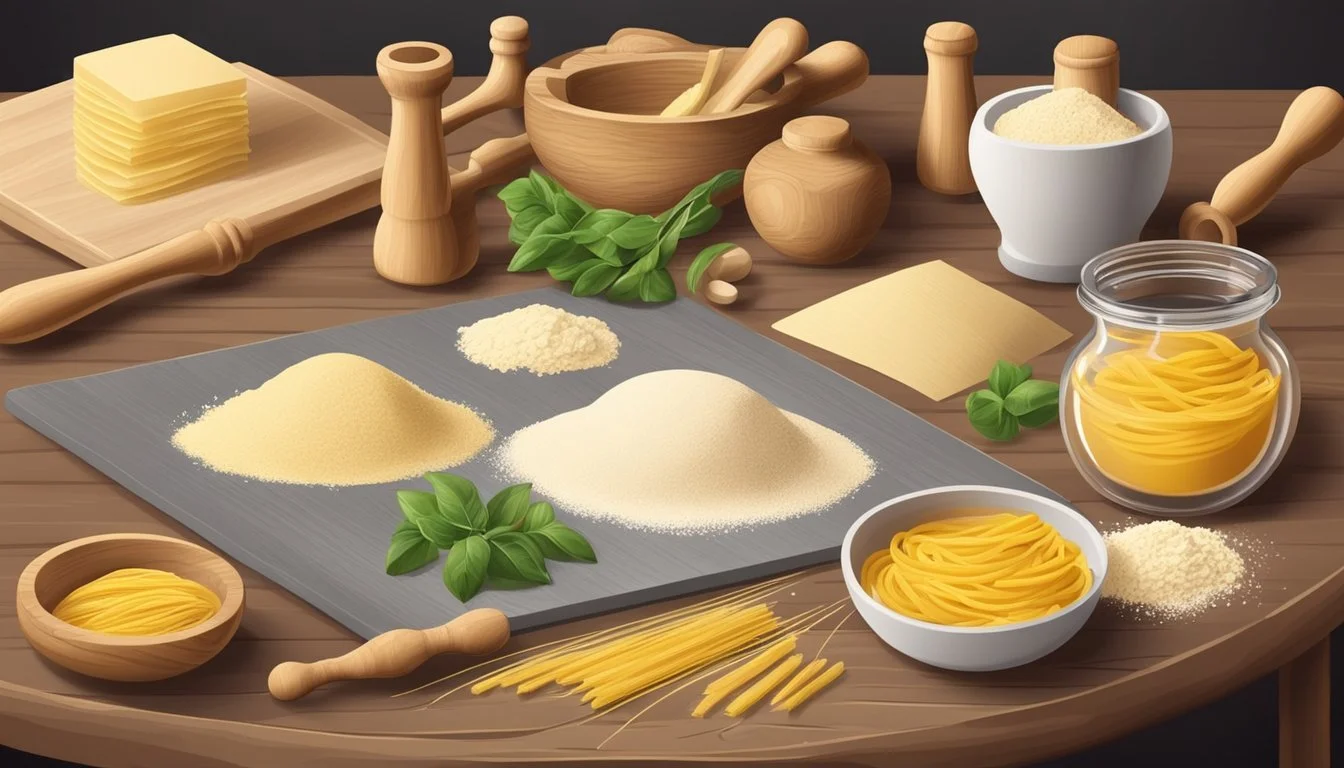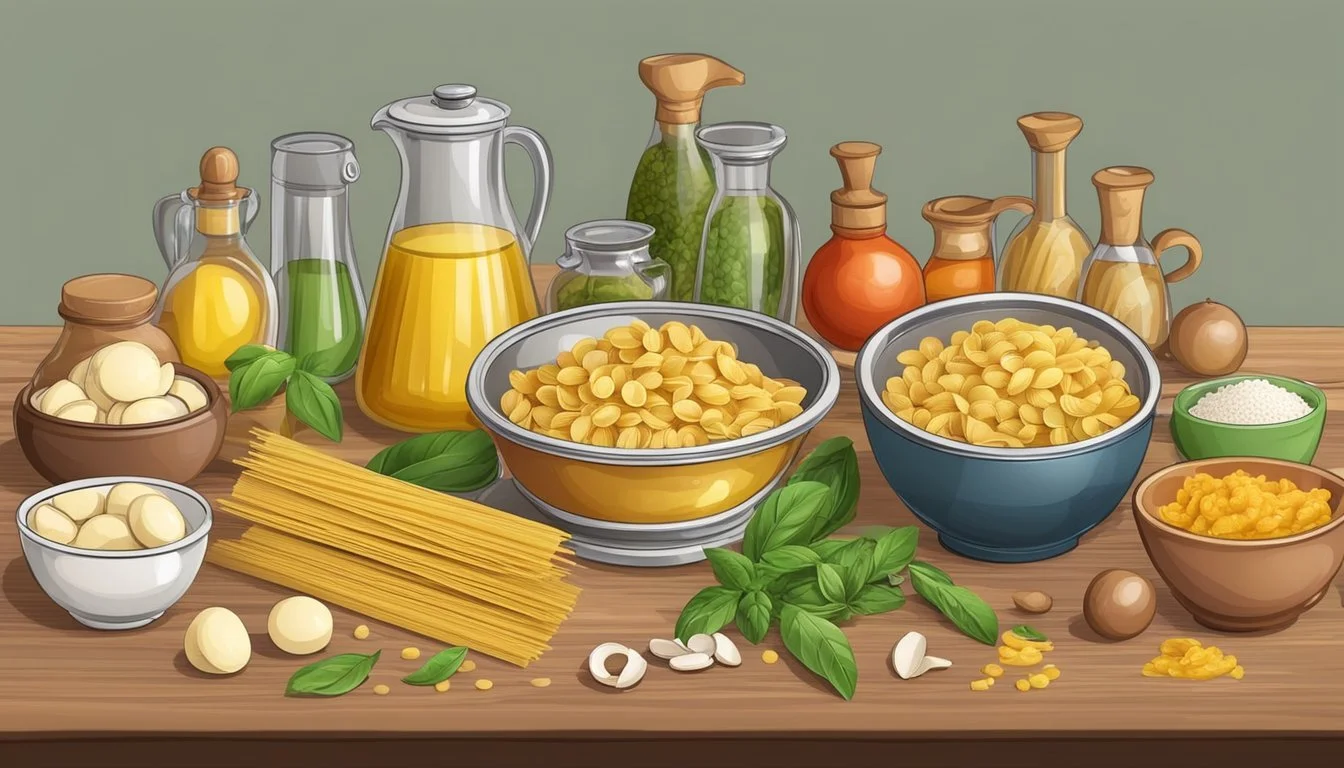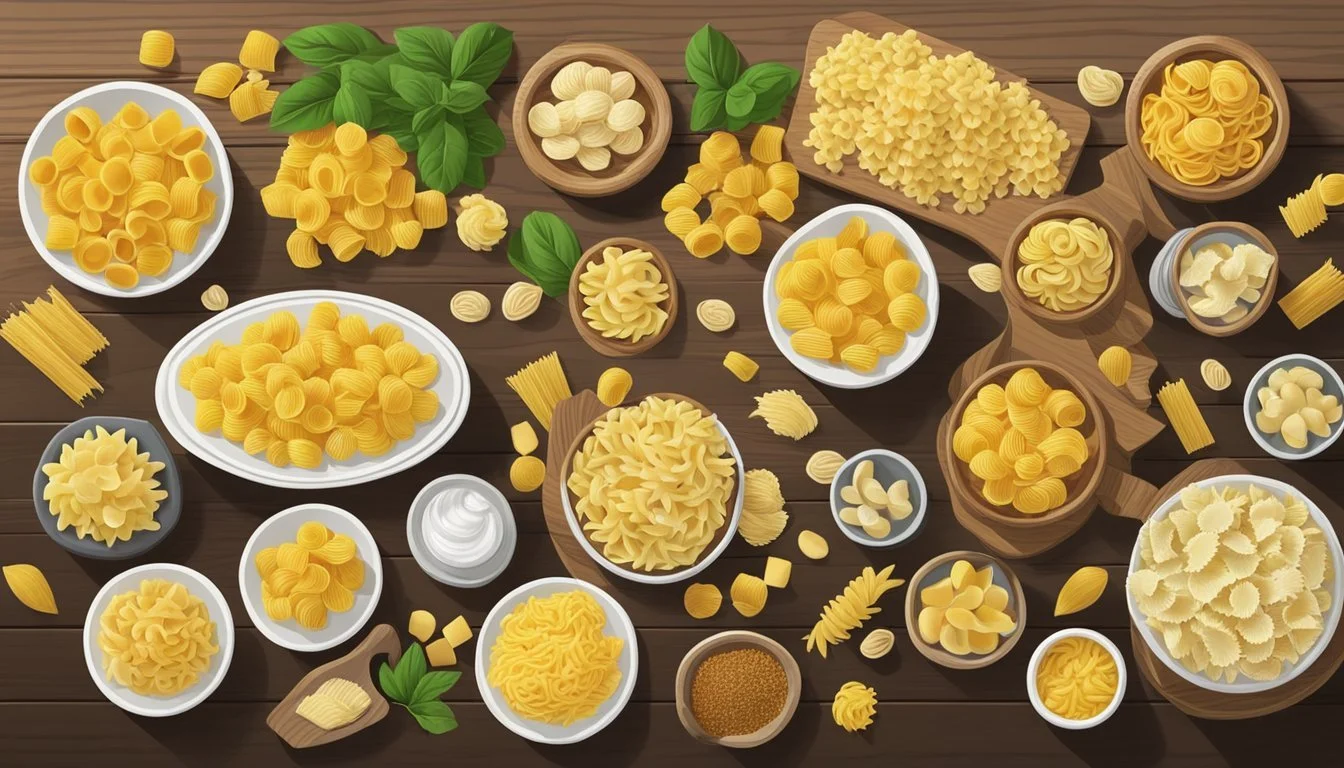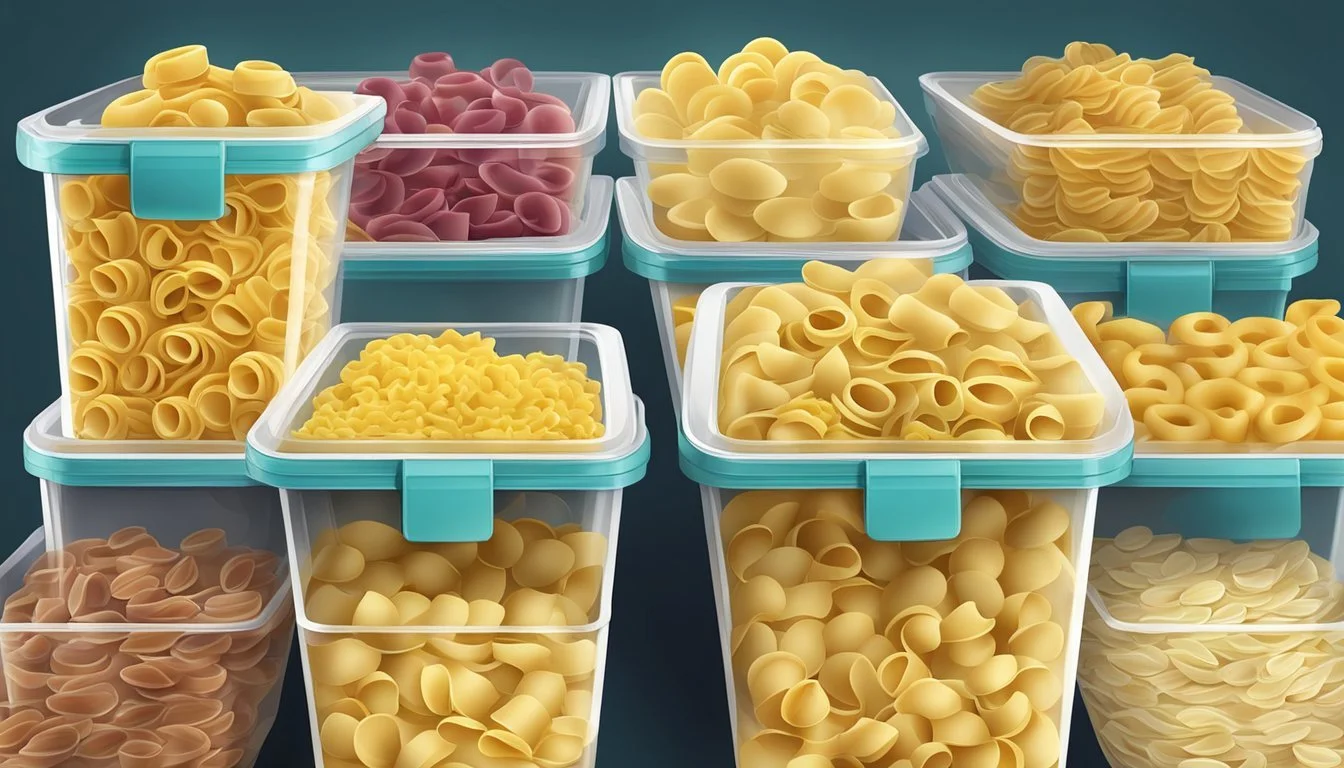Corzetti Pasta Substitutes
Alternative Noodles for Traditional Italian Dishes
Corzetti pasta (What wine goes well with pasta?), originating from the Liguria region in Italy, is a distinctive type of pasta with a history that traces back to the Middle Ages. This traditional pasta comes in the shape of small, embossed coins and is often served with classic regional sauces such as pesto. The unique shape and texture of corzetti make them not just a culinary delight but also a piece of Italy's rich gastronomic heritage.
Finding substitutes for corzetti can be challenging due to its unique characteristics. However, for those looking to explore beyond traditional Ligurian cuisine or seeking alternatives for dietary or availability reasons, there are various options that can emulate the corzetti experience. The key is to approximate the pasta's firmness and capacity to hold onto sauces, which is central to the pleasure of enjoying a dish that's rooted deeply in Italy's culinary tradition.
While no alternative can perfectly replicate the authentic charm of corzetti, pastas like orecchiette or stamped butter cookies could serve as a canvas for similar flavors and textures. The Pasta Project provides enthusiasts with guidance on how to keep within the bounds of Italian customs while experimenting with corzetti pasta substitutes, ensuring that the essence of the Ligurian tradition isn’t lost.
History and Tradition of Corzetti
Corzetti pasta, with its unique shapes and designs, carries a rich history from medieval Italy to modern kitchens. This pasta is not only a culinary delight but also a canvas bearing historical significance and tradition.
Origins in Liguria
In the region of Liguria, Italy, nestled along the coast adjacent to France, corzetti (also known as croxetti) emerged during the Middle Ages. This pasta has two main variations; corzetti valpolceveraschi, which are twisted into an '8' shape, and corzetti del Levante, notable for their flat, round appearance. The latter traditionally originates from the area of Varese Ligure and is embossed with intricate designs.
Renaissance-Era Popularity
The Renaissance period, especially in and around the affluent maritime city of Genoa, saw the rise in popularity of corzetti. Wealthy families would host lavish banquets where corzetti were served as a symbol of their status. The pasta was made using wooden hand-carved molds that were often passed down through generations.
Symbolism and Coat of Arms
Corzetti pasta carries more than culinary delight; it's also a holder of symbolism. During the Renaissance, the practice of stamping corzetti with a family's coat of arms was a way to showcase aristocratic heritage. Each pasta disk was like a piece of art, with designs ranging from family emblems to symbols of Europe's rich culture and history. These designs were not only decorative but also helped the sauce cling to the pasta, making every bite flavorful.
Making Corzetti Pasta
In making Corzetti Pasta, the focus is on traditional ingredients, the distinctive corzetti stamp, and the precise techniques of rolling and cutting the dough to achieve the pasta's signature appearance.
Traditional Ingredients
Corzetti pasta, originating from the Liguria region of Italy, requires a few key ingredients to create its classic dough. One typically needs:
Eggs: Core to providing the rich texture and binding the flour.
Wheat Flour: The base of the pasta dough, providing structure.
Water: Adjusts the consistency of the dough.
Olive Oil: A few drops can be added for flavor and to tenderize the dough.
To make the dough, chefs mix these ingredients to achieve an elastic consistency, ideal for stamping and boiling.
The Corzetti Stamp
The corzetti stamp, a traditional wooden mold, is essential to give Corzetti Pasta its unique embossed design. Pasta dough is pressed with the stamp to create patterns that not only are beautiful but also help sauces cling to the pasta. Corzetti stamps often come in two parts: a cutter to shape the pasta and a design stamp.
Rolling and Cutting
Proper thickness is key when rolling the pasta dough. It should be rolled into thin sheets before using the wooden cutter part of the corzetti stamp to cut into discs. The discs are then individually stamped with the design part of the mold. After crafting the intricate designs, the pasta is left to dry slightly before cooking, ensuring it holds shape and texture during boiling.
Corzetti Pasta Substitutes
Finding an alternative to Corzetti pasta means considering different pasta shapes, ingredients that can be used in their creation, and whether to opt for homemade or store-bought versions. Key considerations include the desired flavor profile, texture, and the equipment available for making fresh pasta.
Alternative Pasta Varieties
For those seeking a shape similar to Corzetti, one might consider stamped ravioli or other coin-shaped pasta. These can offer a comparable aesthetic and surface area for holding sauce. Classic pasta varieties like fettuccine or orecchiette can serve as suitable stand-ins when a precise Corzetti substitute is not necessary.
Substitute Ingredients
While traditional Corzetti is made with all-purpose flour and egg, alternatives can be crafted using different types of wheat or gluten-free flours for dietary considerations. Here's a comparison of ingredients for traditional and substitute Corzetti pasta:
Ingredient Traditional Corzetti Substitute Flour All-purpose flour Whole wheat / Gluten-free blends Binding Agent Egg Water / Olive oil
For those avoiding eggs, incorporating olive oil and water can yield a pasta dough that is still easy to handle and shape.
Homemade versus Store-Bought Options
Individuals owning a pasta machine, whether hand-cranked or electric, can explore making Corzetti at home, providing control over the ingredients and thickness of the pasta. When time or equipment is limited, one might opt for store-bought options. Frozen pasta varieties are readily available and can be a convenient alternative, though they may not provide the same texture as freshly made Corzetti.
Fresh pasta dough, whether homemade or purchased, allows for customization of thickness and flavor, and typically results in a more authentic experience compared to dried or frozen varieties.
Pairing Sauces and Corzetti
Corzetti, a traditional Italian pasta shape from Liguria, is well-suited for hearty, herby sauces that cling to its embossed surface. To honor the pasta’s heritage and potential, it’s important to consider sauces that complement its unique texture and shape.
Classic Ligurian Sauces
Pesto Genovese: This classic Italian recipe blends sweet basil, pine nuts, garlic, Parmigiano cheese, and olive oil to create a sauce that is rich and aromatic. The vibrant green of the pesto contrasts beautifully with the stamped pattern of the corzetti, allowing the herbaceous flavors to enhance the pasta's subtle taste.
Ingredients:
Fresh basil
Pine nuts
Garlic cloves
Grated Parmigiano cheese
Extra-virgin olive oil
Walnut Sauce: Another traditional sauce that pairs with corzetti is the Walnut Sauce, which provides a creamy, nutty flavor profile. It usually includes soaked walnuts, garlic, and Parmigiano cheese, all finely blended with olive oil. This sauce sticks to the pasta for a mouthful of flavor in every bite.
Ingredients:
Soaked walnuts
Garlic cloves
Grated Parmigiano cheese
Extra-virgin olive oil
Modern Interpretations
Tomato Based Sauces: Corzetti also pairs well with rich tomato sauces, seasoned with a blend of savory herbs. A slow-simmered sauce with tomatoes, white wine, onions, and various herbs brings a Mediterranean flair to the dish. The slight indentation in corzetti is perfect for capturing pockets of this zesty sauce.
Genovese Meat Sauce: For a heartier option, a slow-cooked Genovese meat sauce known as 'al tocco di carne', made with veal, pork, white wine, and herbs, is an indulgent choice. This dense sauce with tender chunks of meat nestles into the grooves of corzetti, making each piece a luxurious bite.
Butter-Based Sauces: A simple yet elegant option is to dress corzetti with butter melted and infused with herbs. This allows the natural flavor of the pasta to shine through, complemented by the rich, silky sauce. Freshly grated Parmigiano cheese can be sprinkled atop for an added layer of flavor and texture.
Complementary Ingredients
Corzetti pasta offers a versatile canvas for a medley of complementary ingredients that can enhance its delicate flavor and contribute beneficial nutrients such as protein, fiber, vitamins, and antioxidants.
Vegetables and Herbs
Corzetti pairs well with vegetables that offer a balance of textures and flavors. Green beans and potatoes, boiled until tender, can be tossed with the pasta for a hearty addition rich in fiber and vitamins. Herbs such as basil, fresh marjoram, and parsley can be finely chopped and sprinkled over the pasta to infuse it with aromatic freshness.
Vegetables:
Green beans: Steamed or sautéed
Potatoes: Boiled and diced
Herbs:
Basil: Fresh, chopped
Marjoram: Fresh, leaves removed from stems
Parsley: Fresh, finely chopped
Nuts and Cheeses
To add texture and depth to Corzetti, one can introduce pine nuts or walnuts, lightly toasted to bring out their nutty essence. Cheeses like Parmigiano offer a salty, umami flavor and a dose of protein. When selecting a cheese, one should consider its melting qualities and flavor intensity to complement the pasta.
Nuts:
Pine nuts: Toasted
Walnuts: Toasted and chopped
Cheeses:
Parmigiano: Grated or shaved
Meats and Plant Proteins
For those seeking a protein boost, beef can be an excellent addition to Corzetti, either ground and cooked or as thin slices of steak. Alternatively, plant-based proteins like various beans serve not only as a protein source but also offer fiber and additional antioxidants, perfect for a balanced, nutritious dish.
Meats:
Beef: Ground or thinly sliced
Plant Proteins:
Beans: Cooked; choices include black beans, cannellini, or chickpeas
Cooking Techniques and Tips
When preparing substitutes for Corzetti pasta, achieving the ideal texture and ensuring that the sauce adheres properly are crucial. These techniques will guide cooks in crafting a satisfactory alternative to the traditional Ligurian pasta medallions.
Achieving Al Dente Texture
To attain the al dente texture, which is tender yet firm to the bite, timing and water temperature are essential. Cooks should use a large pot of boiling water to ensure even cooking. When using alternatives to Corzetti, like farfalle or orecchiette, they should refer to the package instructions for approximate boiling times and adjust based on thickness. To check for doneness, one should taste a piece. It should be slightly resistant in the center. A general guideline for achieving al dente pasta includes:
Start testing 2 minutes before the package recommends as cooking times can vary.
Fresh pasta made with eggs or egg yolks tends to cook faster than dried.
Sauce Adhesion Methods
Sufficient sauce adhesion is critical for flavor. Egg based pastas, like Corzetti, often have a natural affinity for sauces due to their smooth texture and rich content. For substitutes that lack eggs, cooks can employ several techniques to enhance sauce adherence:
Before draining, reserve a cup of pasta cooking water. The starchy water helps sauces cling to the pasta.
Toss the pasta with the sauce over low heat to help emulsification. Use butter or olive oil as bases to achieve a silky texture.
Do not rinse the pasta after cooking, as it removes the starches critical for binding sauce to pasta.
Following these specific cooking techniques will ensure your pasta dish comes close to the unique experience of enjoying Corzetti, even with substitute pasta shapes.
Serving and Presentation
When serving corzetti, the key is to showcase its unique shape and embossed design. The plating should enhance the visual appeal, and the garnishes are selected to complement the pasta's subtle flavor profile.
Plating Corzetti
Corzetti pasta medallions should be plated neatly to highlight their distinctive stamped patterns, which are a hallmark of this pasta variety. Ideal plating involves laying the corzetti in a single layer to allow diners to appreciate the artistry. Serve with sauces that cling to the grooves, such as a light butter or olive oil-based sauce, allowing the pasta's design to remain visible.
Garnishes and Accents
Garnishes not only add flavor but also color and texture, enhancing the overall dining experience. A sprinkle of grated parmesan or parmigiano can add a sharp, savory note, while pine nuts provide a crunchy contrast to the pasta's tender bite. For a fresh element, consider finely chopped basil. To add sweetness and a seasonal touch, incorporate roasted cubes of butternut squash. Lastly, a twist of lemon zest or a couple of lemon slices can bring a bright, citrusy accent to the dish.
When plating, remember that each garnish should be used thoughtfully to avoid overwhelming the delicate flavor of the corzetti. Diners should be treated to a harmonious blend of tastes that says, "buon appetito," with every bite.
Storing and Preserving Corzetti
Proper storage methods are essential to ensure Corzetti pasta maintains its texture and flavor. Whether refrigerating freshly made pasta for short-term use or drying it for long-term storage, adhering to the right techniques can make a substantial difference.
Refrigeration and Freezing
When refrigerating Corzetti, it's best to place them on a tray lined with a kitchen towel to absorb any excess moisture. They may be refrigerated like this for up to two days. For freezing, one should first spread the pasta pieces on a baking sheet and freeze them until they are firm, which usually takes a few hours. Once firm, transfer the Corzetti into airtight bags or containers to prevent freezer burn. Frozen Corzetti can last for up to three months. To use frozen Corzetti, one can cook them directly from the freezer by plunging them into boiling pasta water for an extended cooking time.
Drying and Rehydration
Drying Corzetti involves laying the pieces out in a single layer, ensuring good air circulation and a dry environment. A food dehydrator can expedite this process, or they can be air-dried for 24 to 48 hours, depending on humidity. Once dried, Corzetti should be stored in an airtight container in a cool, dry place. They will be good for several months. To rehydrate, simply boil them as one would with fresh or dried Corzetti, being mindful that rehydration may require extra cooking time to achieve the desired tenderness.
Cultural Significance and Modern Adaptations
In the realm of pasta, corzetti stands out not just for its distinct shape but also for its regional and cultural importance in Liguria. Modern adaptions honor its tradition while inviting creativity in global cuisine.
Corzetti in Ligurian Cuisine
Corzetti pasta, originating from the Ligurian region of Italy, particularly the Val Polcevera area, embodies a storied past that dates back to the Middle Ages. Local households and communities throughout Liguria have revered this pasta for centuries, with each authentic Italian pasta recipe reflecting the region's culinary ethos. Historically, corzetti is recognized by its emblematic stamp, which often bears a family crest or symbolic design, highlighting the importance of heritage in Ligurian cooking practices.
Global Influence and Fusion
As corzetti transcended its Ligurian roots, it encountered an array of global influences, creating a fusion of tastes. Italian emigrants have carried this authentic element of Ligurian cuisine to various corners of the world, adapting the recipe to local tastes and ingredients. In regions like Tuscany, a Florentine touch might be added, while internationally, chefs have been known to incorporate non-traditional ingredients, rendering scrumpitouns interpretations that still nod to the corzetti tradition. Across the globe, these adaptations are a testament to the versatility and enduring appeal of this Italian recipe.










